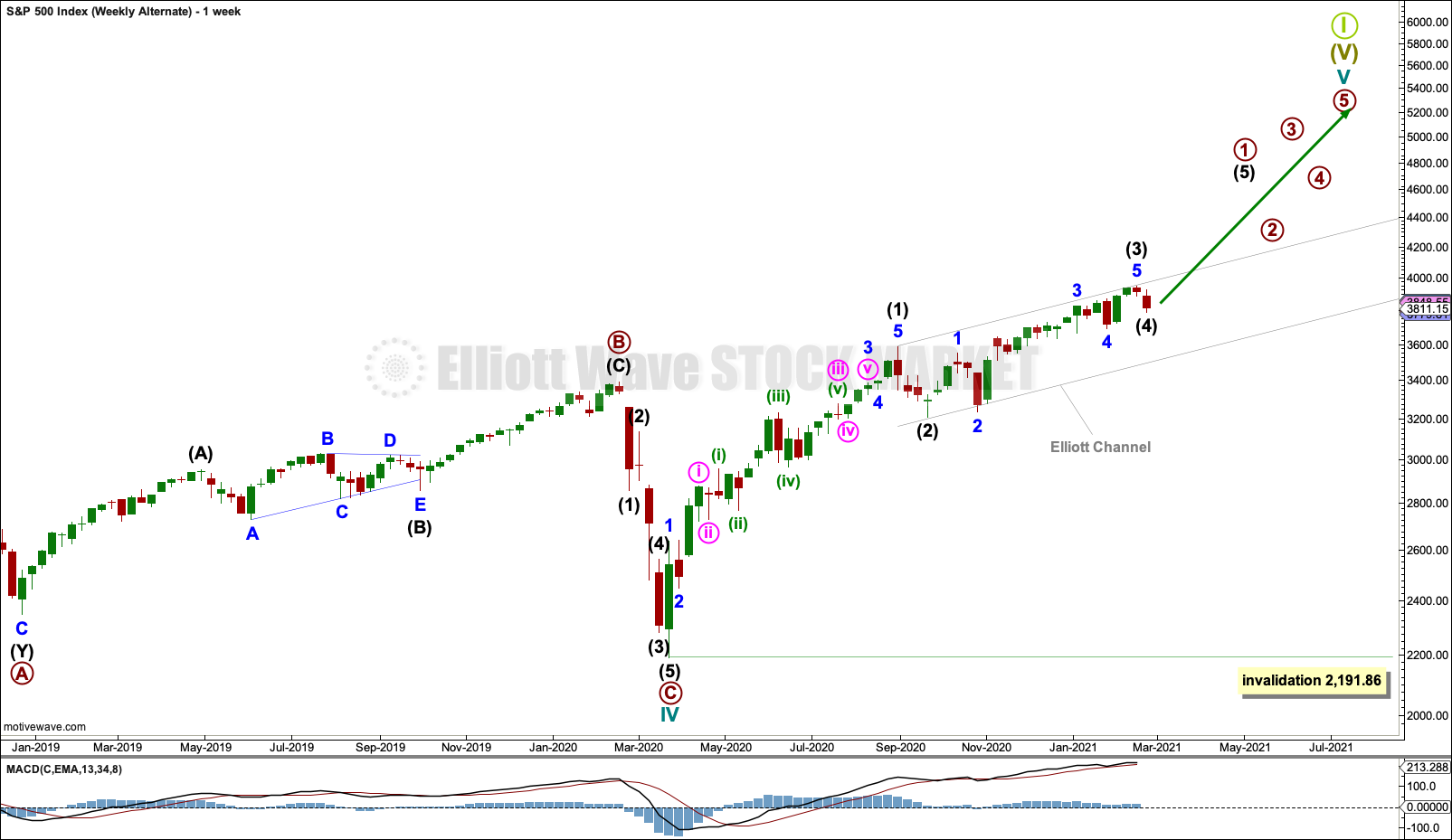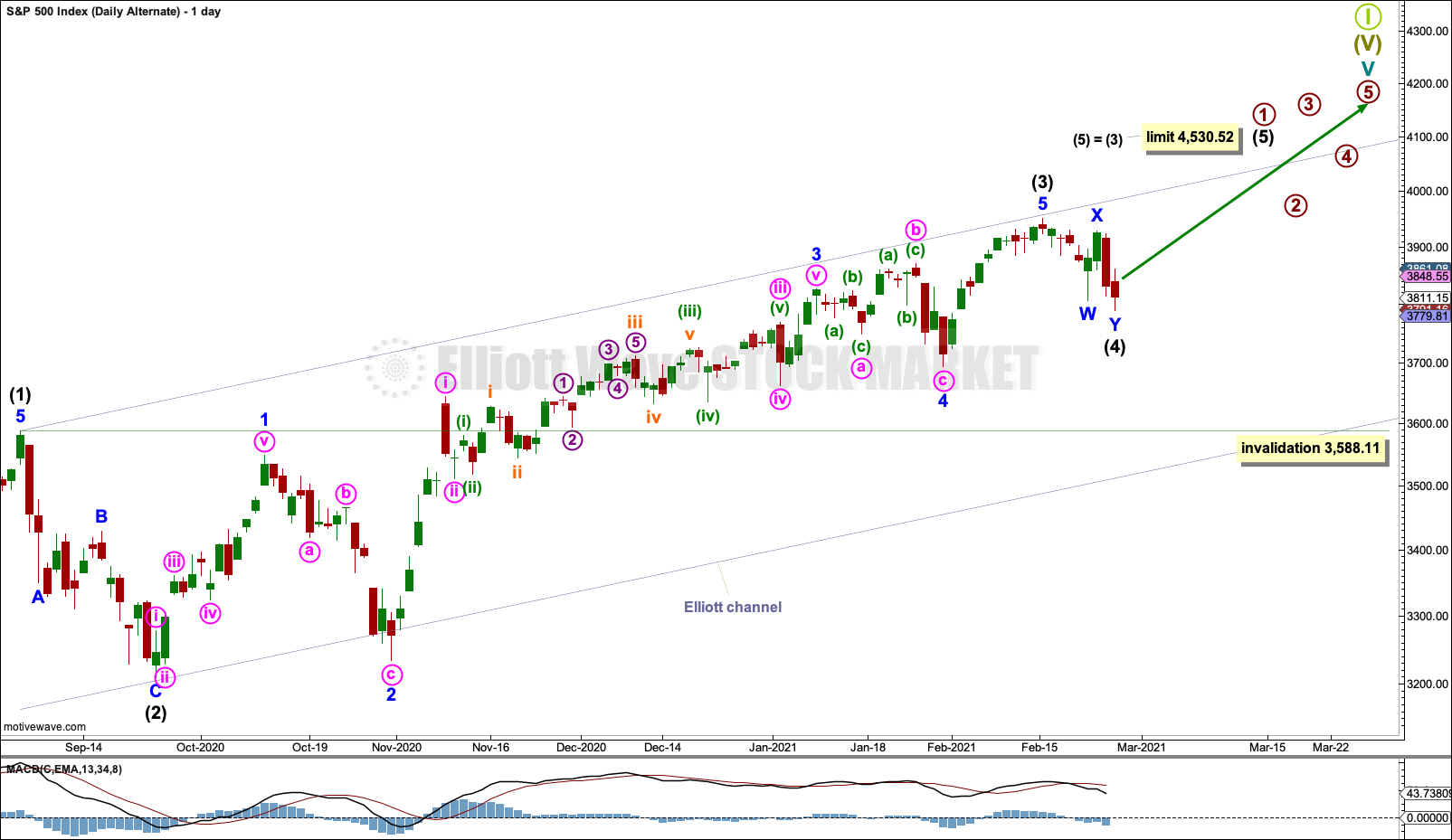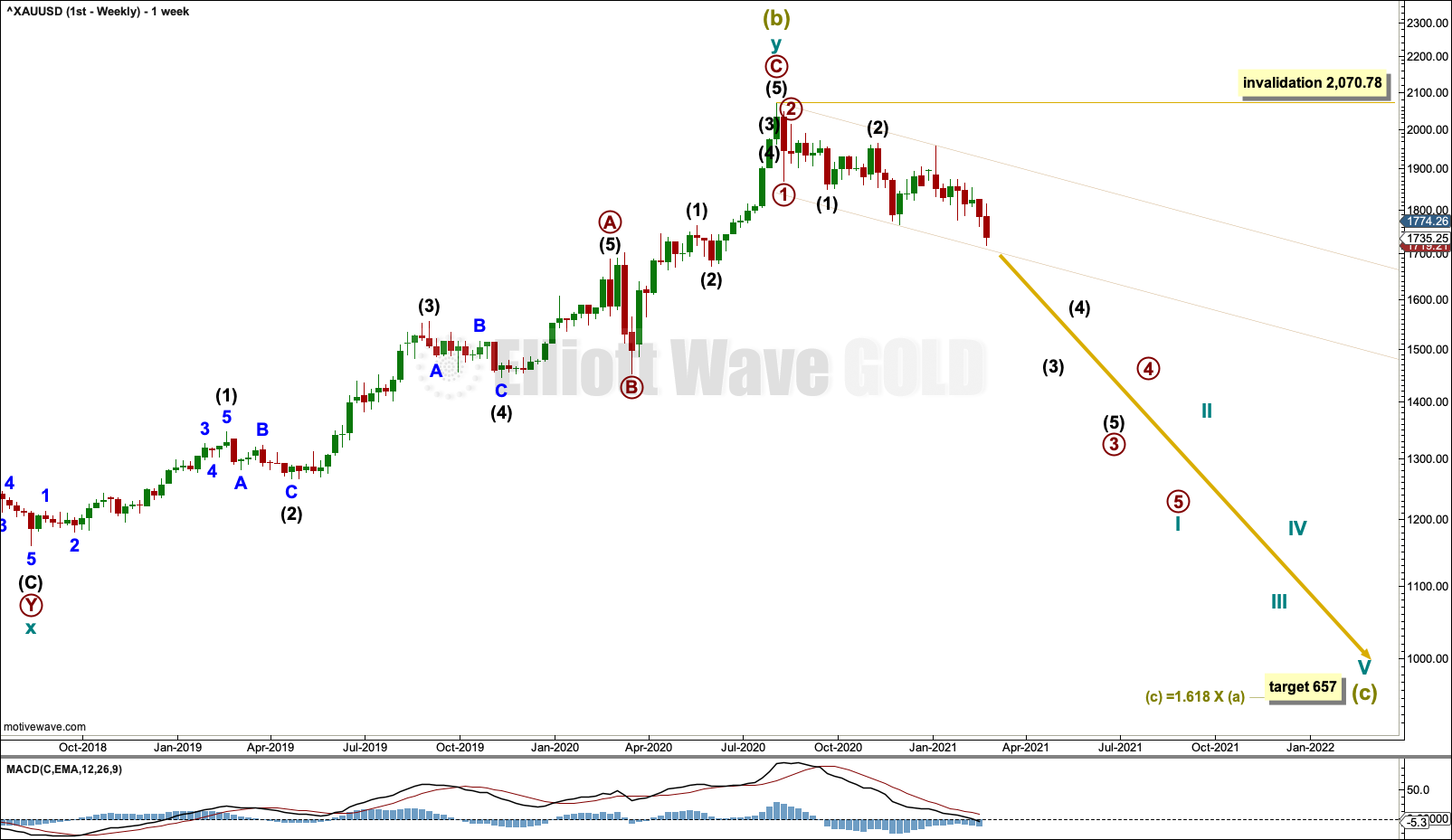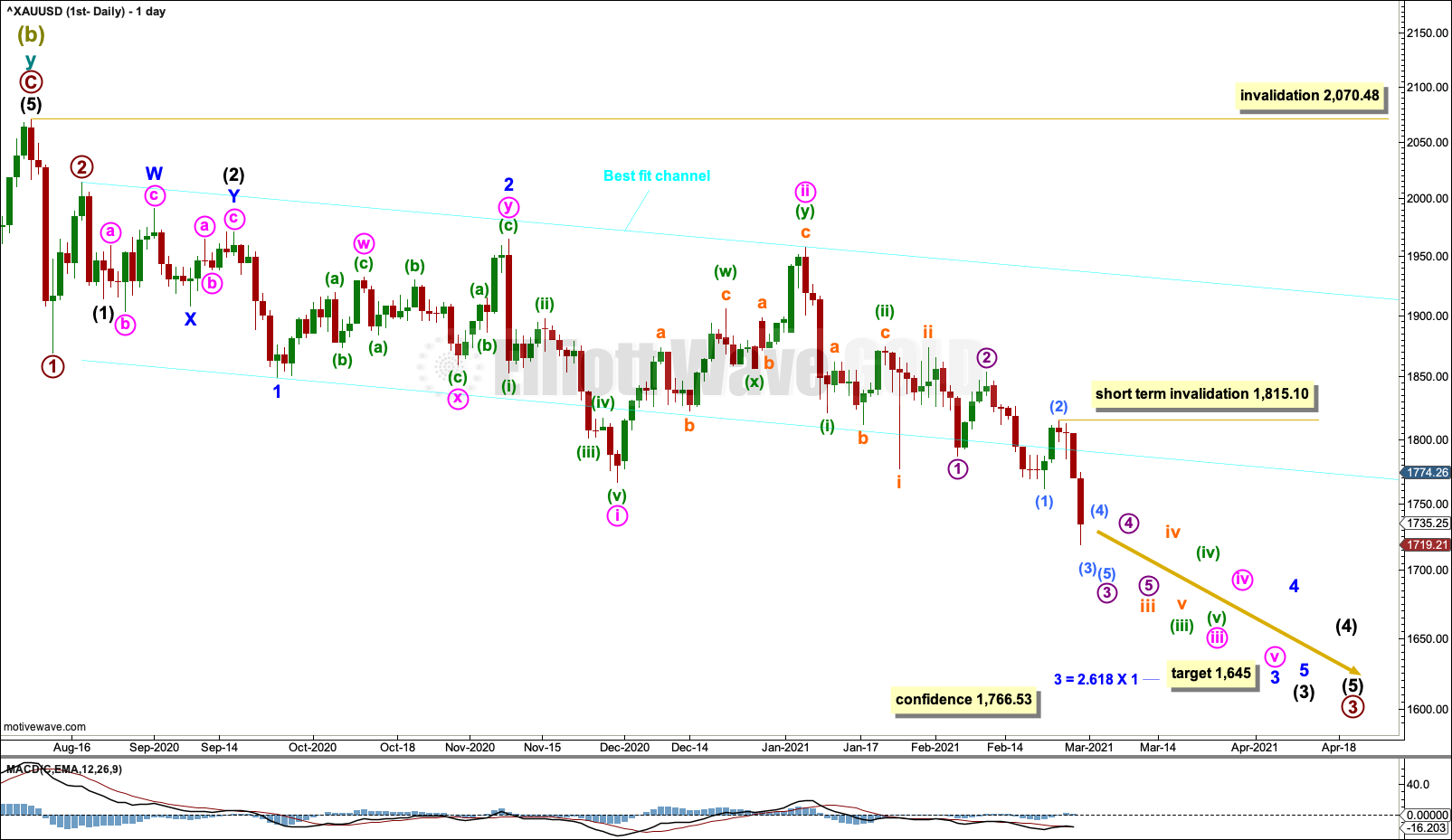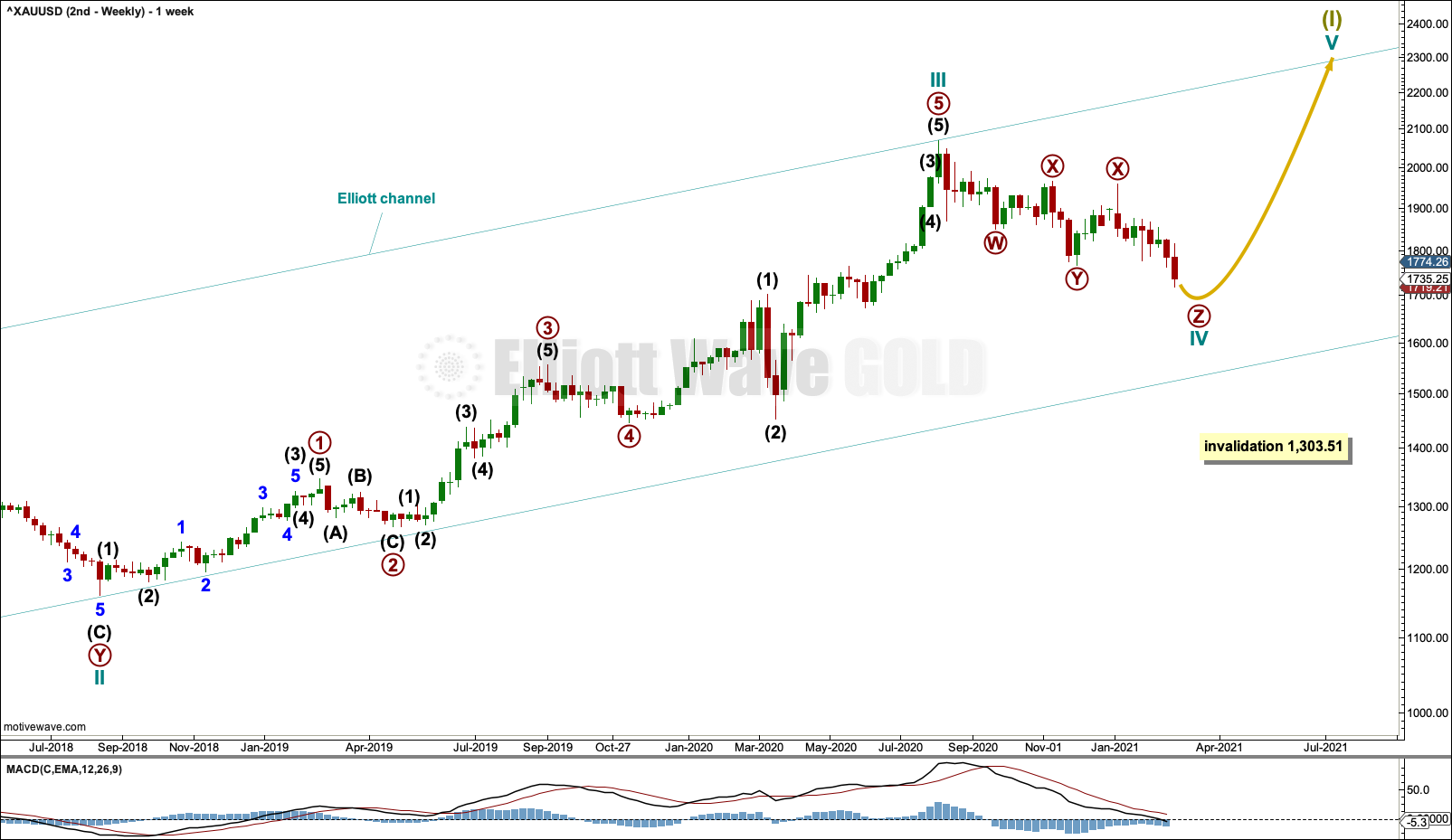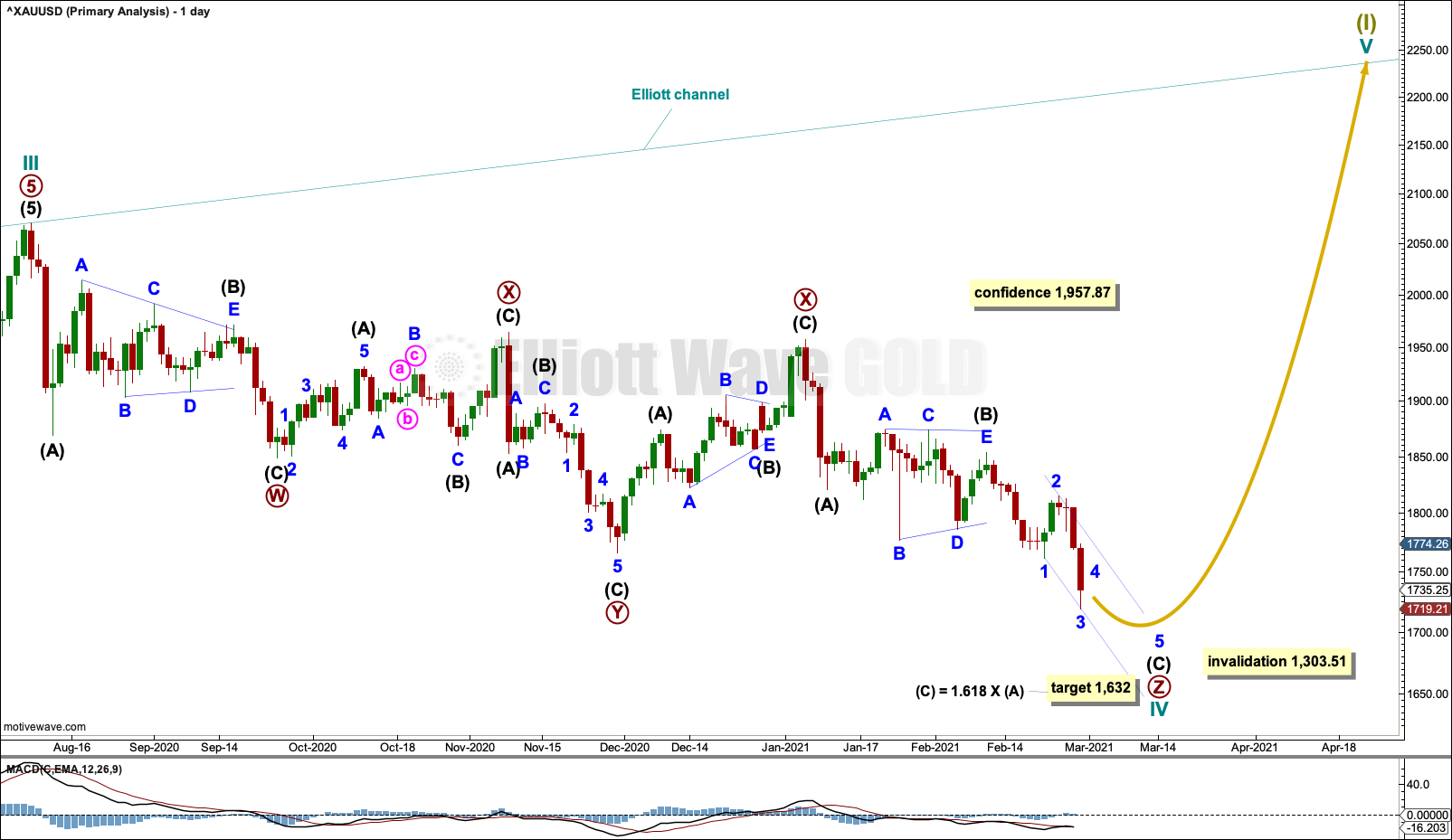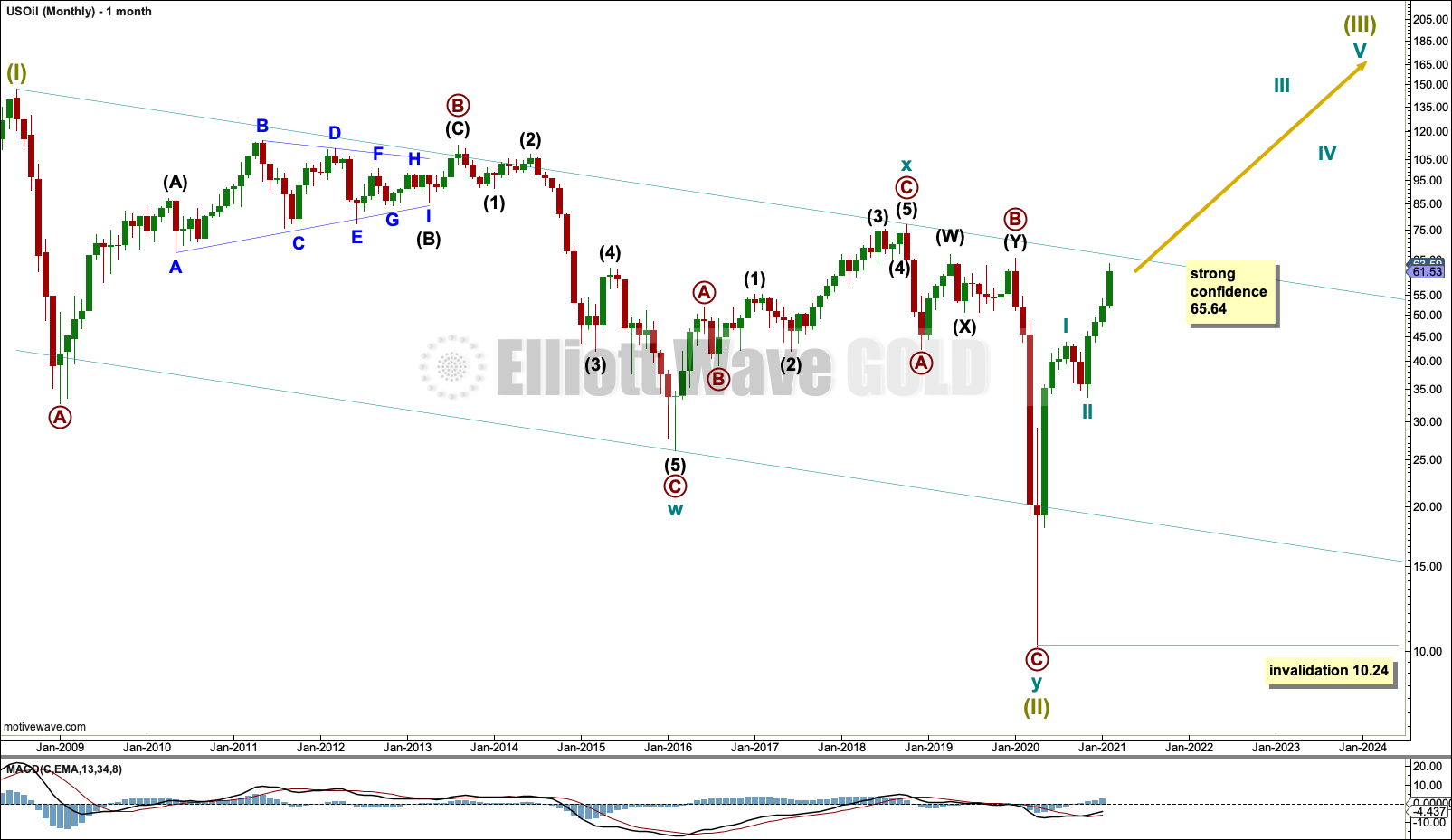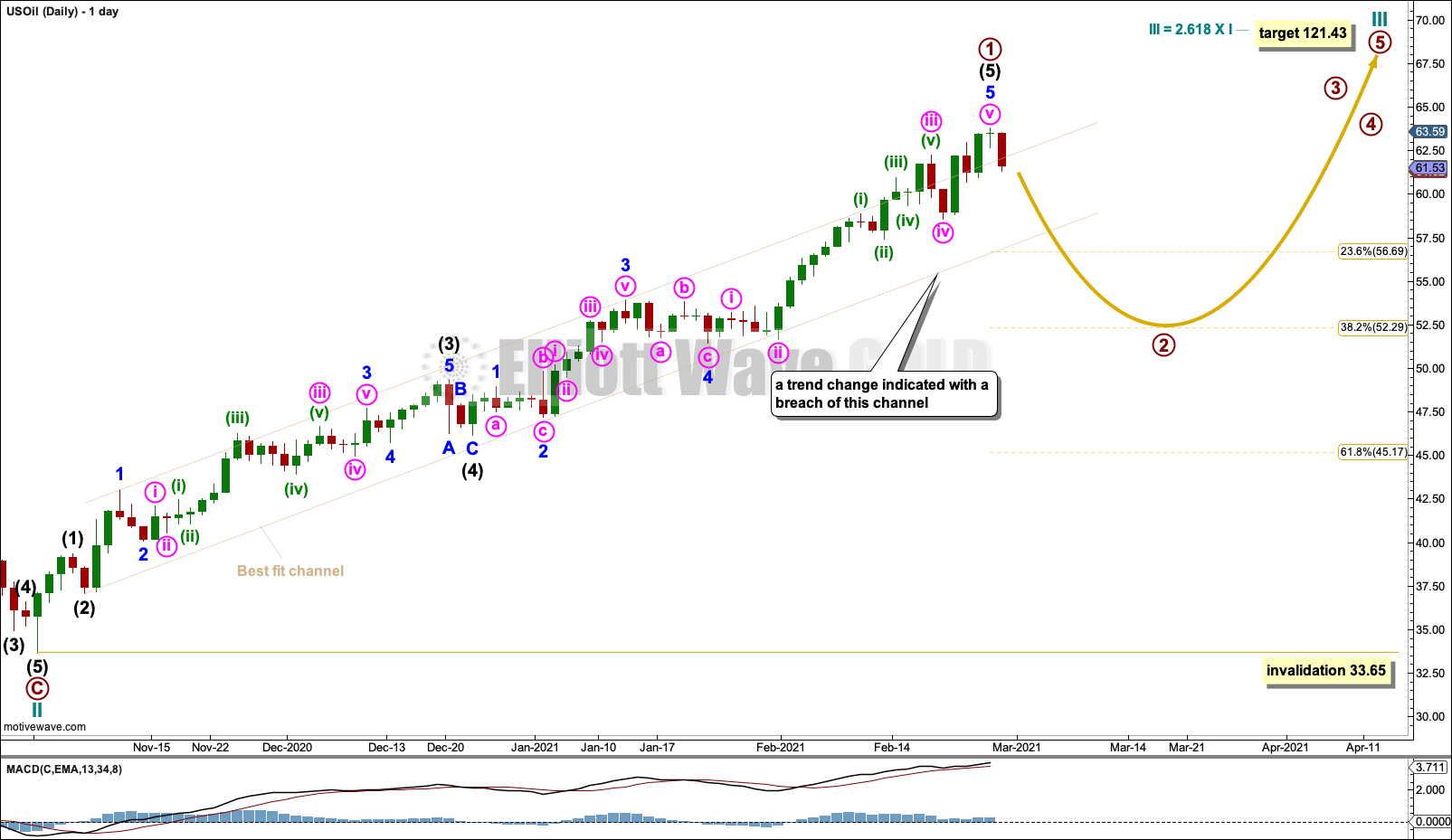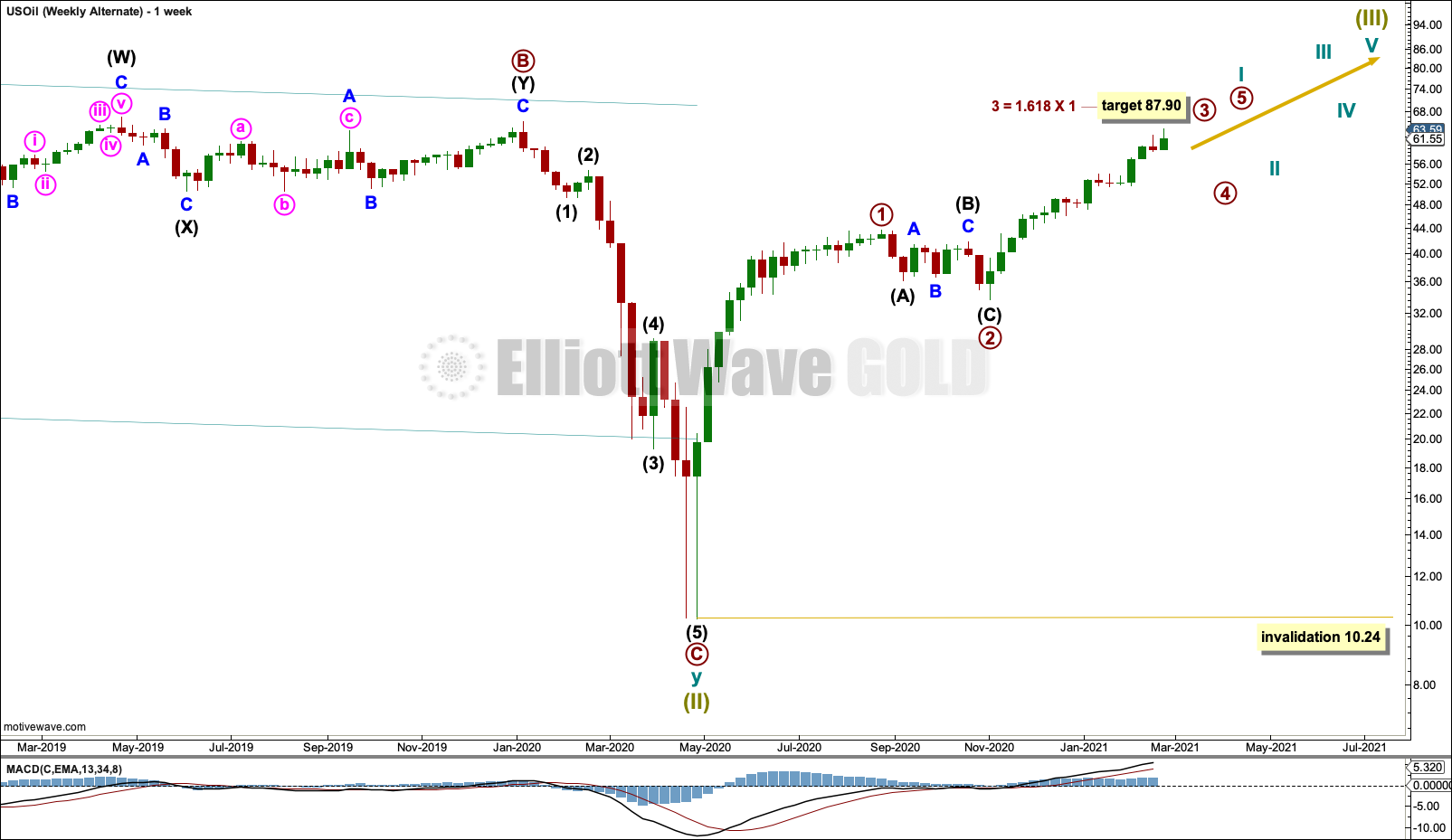Lara’s Weekly: Elliott Wave and Technical Analysis of S&P500 and Gold and US Oil | Charts – February 26, 2021

S&P 500
In yesterday’s analysis members were warned that an 80% down day and bearish signals from the AD line and VIX suggested more downwards movement was possible for Friday, which is what has happened.
Summary: The pullback may be over at this week’s low, or it may continue sideways as a triangle or flat correction for several more sessions.
Both main and alternate wave counts expect the low of the 30th of October to not be breached for many months.
The next target for the upwards trend is at 4,606. About this target another multi-week pullback or consolidation may develop.
An alternate wave count at the weekly chart level has an about even probability with the main weekly chart.
The biggest picture, Grand Super Cycle analysis, is here.
Last monthly charts are here. Video is here.
MAIN WAVE COUNT
WEEKLY CHART
Cycle wave V may last from one to several years. So far it is in its eleventh month.
This wave count may allow time for the AD line to diverge from price as price makes final highs before the end of the bull market. The AD line most commonly diverges a minimum of 4 months prior to the end of a bull market. A longer divergence is positively correlated with a deeper bear market. A shorter divergence is positively correlated with a more shallow bear market. With zero divergence at this stage, if a surprise bear market does develop here, then it would likely be shallow.
Cycle wave V would most likely subdivide as an impulse. But if overlapping develops, then an ending diagonal should be considered. This chart considers the more common impulse.
Primary waves 1 and 2 may be complete.
Primary wave 3 may only subdivide as an impulse.
Primary wave 3 has now moved well above the end of primary wave 1. Primary wave 4 may not move into primary wave 1 price territory below 3,588.11.
There is already a Fibonacci ratio between cycle waves I and III within Super Cycle wave (V). The S&P500 often exhibits a Fibonacci ratio between two of its actionary waves but rarely between all three; it is less likely that cycle wave V would exhibit a Fibonacci ratio. The target for Super Cycle wave (V) to end would best be calculated at primary degree, but that cannot be done until all of primary waves 1, 2, 3 and 4 are complete.
The blue weekly best fit channel is slightly adjusted, so that the lower edge may better show where price may find support. Copy this over to the daily chart.
DAILY CHART
The daily chart focusses on the unfolding impulse of primary wave 3.
Given the size of downwards movement this week, the degree of labelling within primary wave 3 is moved down one degree. Intermediate wave (1) may have been complete at the last all time high and the current pullback may be intermediate wave (2).
Intermediate wave (2) may be complete as a double zigzag as labelled, or the degree of labelling within it may be moved down one degree to continue sideways as a flat.
Intermediate wave (2) may not subdivide with a triangle as its sole corrective structure; triangles do not occur in second wave positions (unless they are one part of a combination). If the structure of this pullback is correctly analysed as a double zigzag at lower time frames, then intermediate wave (2) may not continue further as a double combination; combinations may only subdivide with simple corrective structures within W, Y and Z.
Intermediate wave (2) may continue lower as a triple zigzag. While triple zigzags are reasonably rare, they are not the rarest Elliott wave structure and may occur in a second wave position.
Intermediate wave (2) may not move beyond the start of intermediate wave (1) below 3,209.45.
ALTERNATE WAVE COUNT
WEEKLY CHART
This wave count moves the degree of labelling within cycle wave V down one degree. Primary wave 1 may be incomplete.
This alternate is more bullish than the main weekly chart. It expects that cycle wave V may last many more years than the main weekly chart. These wave counts are judged still to have about an even probability.
When primary wave 1 may be complete, then a multi-week pullback for primary wave 2 should begin. Primary wave 2 may not move beyond the start of primary wave 1 below 2,191.86.
DAILY CHART
Intermediate waves (1) through to (4) within primary wave 1 may be complete. If it continues lower next week, then intermediate wave (4) may not move into intermediate wave (1) price territory below 3,588.11.
TECHNICAL ANALYSIS
WEEKLY CHART
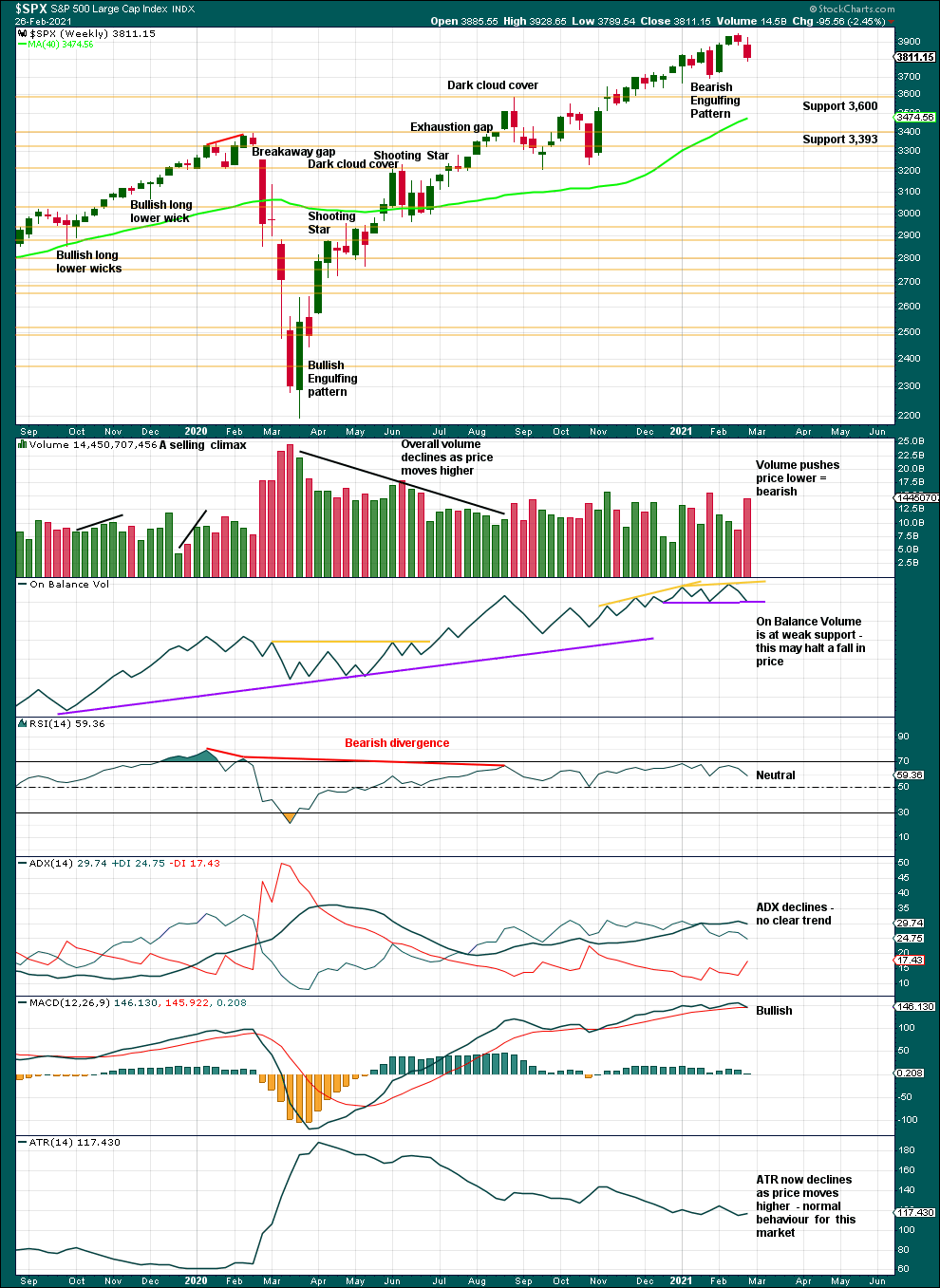
Click chart to enlarge. Chart courtesy of StockCharts.com.
An increase in volume this week is bearish. But within this chart there are two examples of downwards weeks with strong volume occurring at the end of pullbacks: the week beginning October 26, 2020, and the week beginning January 25, 2021. An increase in volume for a downwards week this week does not necessarily mean price should continue lower next week.
ADX now declines this week; but if it turns back up, then an upwards trend would again be indicated.
Support for On Balance Volume is met, but it is weak.
DAILY CHART
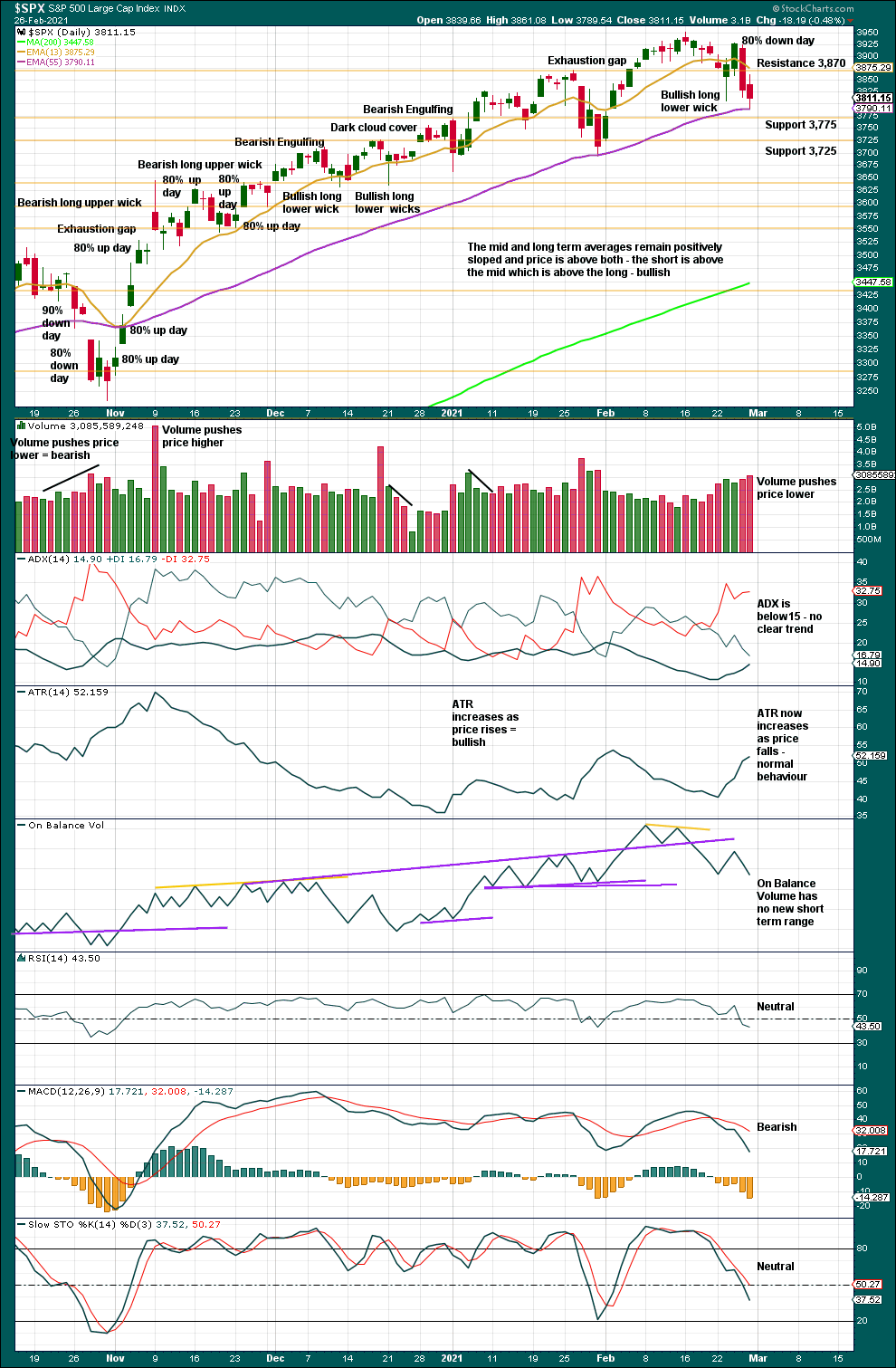
Click chart to enlarge. Chart courtesy of StockCharts.com.
The series of higher highs and higher lows from the low of the 30th of October continues.
ADX is a lagging indicator. The many small pullbacks in this trend are causing it to lag in identifying an obvious upwards trend.
The breakaway gap is closed; it is renamed an exhaustion gap. This supports a short-term bearish outlook but makes no comment on how low a pullback may go.
Next support is at 3,775. The last swing low on the 29th of January remains intact; while this has not been breached, an upwards trend may be assumed to remain in place as a series of higher highs and higher lows remains. Pullbacks are a normal part of an upwards trend.
One or more of the following may be seen in order to have confidence that this pullback is over:
– A 90% up day or two back to back 80% up days following within 4 sessions of a 90% down day or two back to back 80% down days.
– A bullish signal from On Balance Volume.
– A bullish signal from the AD line.
– A bullish candlestick reversal pattern that has support from volume.
BREADTH – AD LINE
WEEKLY CHART
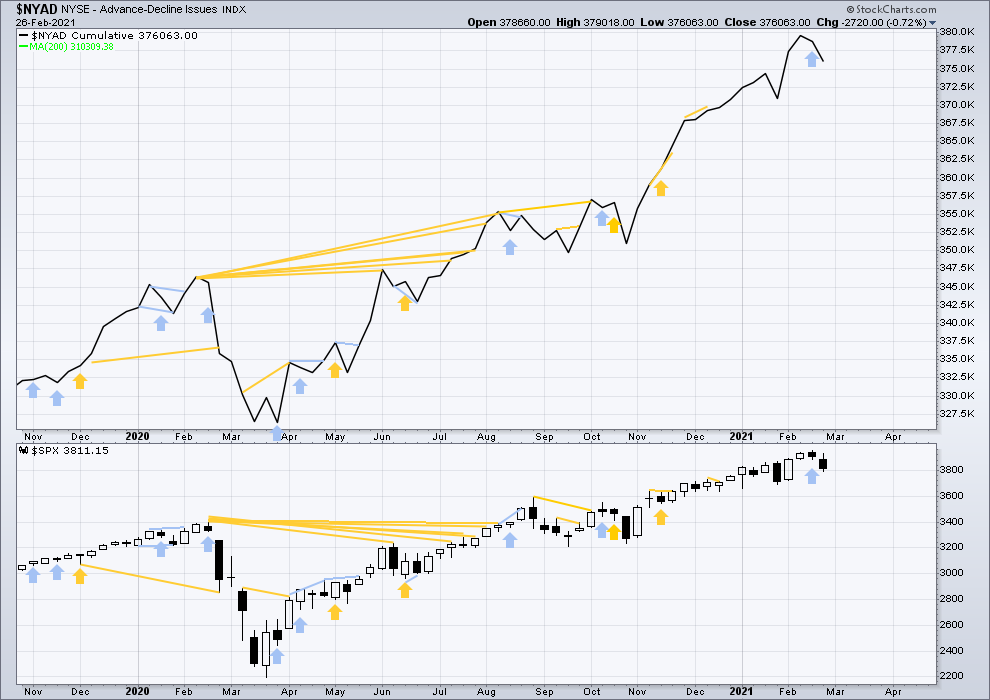
Click chart to enlarge. Chart courtesy of StockCharts.com. So that colour blind members are included, bearish signals will be noted with blue and bullish signals with yellow.
Breadth should be read as a leading indicator.
Lowry’s Operating Companies Only AD line has made a new all time high on the 12th of February. This is a strong bullish signal and supports the main Elliott wave count.
Large caps all time high: 3,950.43 on February 16, 2021.
Mid caps all time high: 2,581.02 on February 24, 2021.
Small caps all time high: 1,325.66 on February 24, 2021.
This week both price and the AD line have moved lower. Neither have made new short-term swing lows. There is no new divergence.
DAILY CHART

Click chart to enlarge. Chart courtesy of StockCharts.com. So that colour blind members are included, bearish signals will be noted with blue and bullish signals with yellow.
Following short-term bearish divergence noted in last analysis, price has moved lower. This divergence may now be resolved.
Today both price and the AD line have moved lower. There is no new divergence.
VOLATILITY – INVERTED VIX CHART
WEEKLY CHART

Click chart to enlarge. Chart courtesy of StockCharts.com. So that colour blind members are included, bearish signals will be noted with blue and bullish signals with yellow.
Inverted VIX remains well below all time highs. The all time high for inverted VIX was in the week beginning October 30, 2017. There is over 3 years of bearish divergence between price and inverted VIX. There is all of long, mid and short-term bearish divergence. This bearish divergence may develop further before the bull market ends. It may be a very early indicator of an upcoming bear market, but it is not proving to be useful in timing.
This week both price and inverted VIX have moved lower. Neither have made new short-term swing lows. There is no new divergence.
Comparing VIX and VVIX at the weekly chart level:
Short-term bearish divergence noted two weeks ago has now been followed by some downwards movement, so it may now be resolved. This week both VIX and VVIX have moved higher. There is no new short-term divergence.
DAILY CHART
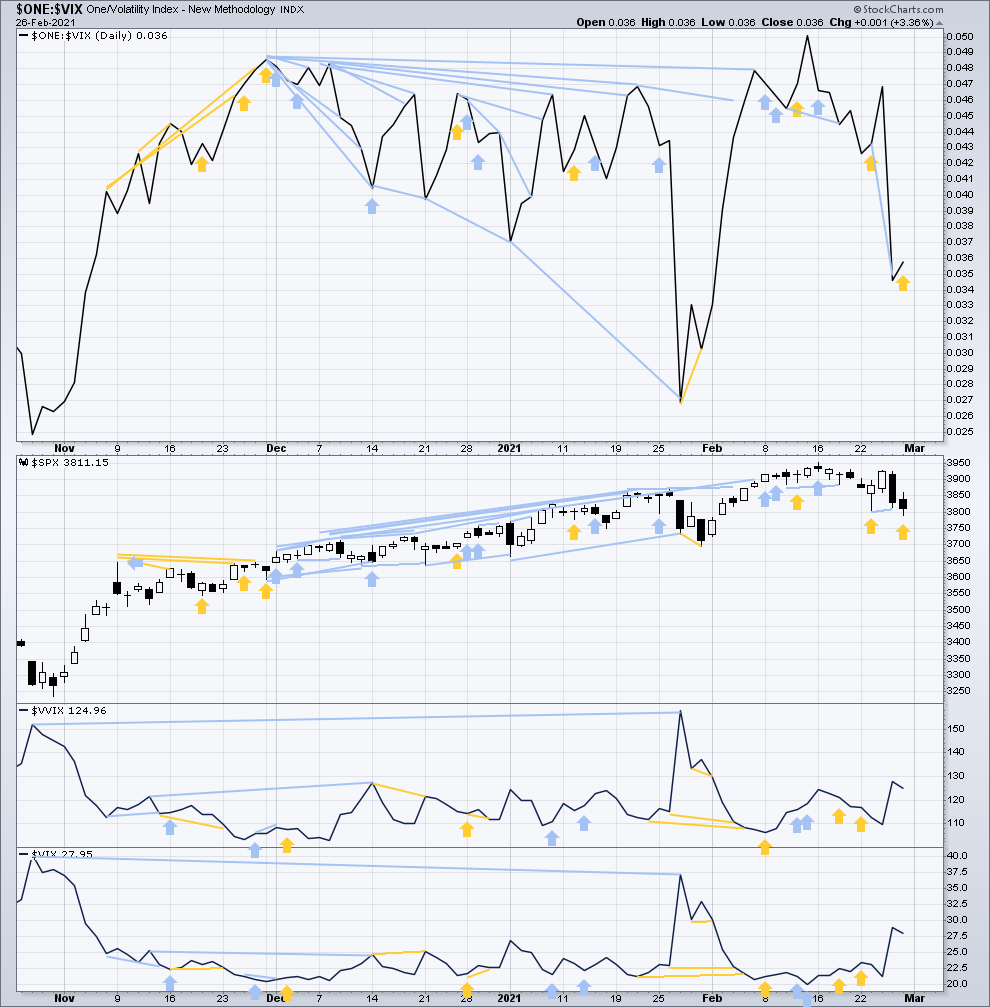
Click chart to enlarge. Chart courtesy of StockCharts.com. So that colour blind members are included, bearish signals will be noted with blue and bullish signals with yellow.
Today price has moved lower, but inverted VIX has moved higher. This divergence is bullish for the short term.
Comparing VIX and VVIX at the daily chart level:
VVIX has made a new high above the high of October 28, 2020, but VIX has not. This divergence remains bearish for the mid term. Today both VIX and VVIX have moved lower. There is no new divergence.
DOW THEORY
Dow Theory confirms a new bull market with new highs made on a closing basis:
DJIA: 29,568.57 – closed above on 16th November 2020.
DJT: 11,623.58 – closed above on 7th October 2020.
Adding in the S&P and Nasdaq for an extended Dow Theory, confirmation of a bull market would require new highs made on a closing basis:
S&P500: 3,393.52 – closed above on 21st August 2020.
Nasdaq: 9,838.37 – closed above on June 8, 2020.
The following major swing lows would need to be seen on a closing basis for Dow Theory to confirm a change from bull to a bear market:
DJIA: 18,213.65
DJT: 6,481.20
Adding in the S&P and Nasdaq for an extended Dow Theory, confirmation of a new bear market would require new lows on a closing basis:
S&P500: 2,191.86
Nasdaq: 6,631.42
GOLD
Downwards movement continues as expected for the first preferred Elliott wave count.
Summary: The first wave count is bearish for the bigger picture and has only one daily chart. This wave count expects a multi-year bear market may be in its early stages to end below 1,046.
Downwards momentum may show a further increase. A short-term target is at 1,645. A long-term target is at 657. Some confidence may now be had in this bearish wave now that price has made a new low below 1,766.53. This wave count may be discarded if price makes a new high above 1,957.87.
The second wave count is bullish for the bigger picture but now bearish for the short to mid term. A new target for a reasonably rare triple zigzag to end is at 1,737 to 1,723.
Grand SuperCycle analysis is here.
Last analysis of monthly charts is here.
FIRST ELLIOTT WAVE COUNT
WEEKLY CHART
The bigger picture for this first Elliott wave count sees Gold as still within a bear market, in a three steps back pattern that is labelled Grand Super Cycle wave IV on monthly charts. Grand Super Cycle wave IV may be subdividing as an expanded flat pattern.
Super Cycle wave (b) within Grand Super Cycle wave IV may be a complete double zigzag. This wave count expects Super Cycle wave (c) to move price below the end of Super Cycle wave (a) at 1,046.27 to avoid a truncation and a very rare running flat. The target calculated expects a common Fibonacci ratio for Super Cycle wave (c).
DAILY CHART
Within a new bear market, cycle wave I may be an incomplete five wave impulse.
Cycle wave II within the new downwards trend may not move beyond the start of cycle wave I above 2,070.48.
Gold typically exhibits extended and strong fifth waves; this tendency is especially prevalent for fifth waves to end third wave impulses one degree higher. One or more of minute wave v, minor wave 5 or intermediate wave (5) may exhibit this tendency; there may be one or more selling climaxes along the way down. Minute wave iv and minor wave 4 may be relatively brief and shallow.
A best fit channel is drawn as shown. The upper edge may be used as a guide for resistance of any deeper bounces. The lower edge is no longer showing where price is finding resistance or support.
No second wave correction within sub-micro wave (3) may move beyond the start of its first wave above 1,815.10.
A new swing low below 1,766.53 adds reasonable confidence to this wave count.
SECOND ELLIOTT WAVE COUNT
WEEKLY CHART
This wave count sees the the bear market complete at the last major low for Gold on 3 December 2015.
If Gold is in a new bull market, then it should begin with a five wave structure upwards on the weekly chart.
Cycle wave I fits as a five wave impulse with reasonably proportionate corrections for primary waves 2 and 4.
Cycle wave II fits as a double flat. However, within the first flat correction labelled primary wave W, this wave count needs to ignore what looks like an obvious triangle from July to September 2016 (this can be seen labelled as a triangle on the second weekly chart on prior analysis here). This movement must be labelled as a series of overlapping first and second waves. Ignoring this triangle reduces the probability of this wave count in Elliott wave terms.
Cycle wave IV has moved lower, so it now must be labelled as incomplete. The only structure cycle wave IV may now be unfolding as would be a relatively rare triple zigzag. The rarity of triples reduces the probability of this wave count further.
Cycle wave IV may not move into cycle wave I price territory below 1,303.51.
DAILY CHART
Cycle wave IV may be continuing lower as a relatively rare triple zigzag.
The third zigzag in a triple may now be completing lower. Primary wave Z may now be completing intermediate wave (C).
Intermediate wave (C) must subdivide as a five wave motive structure.
The purpose of multiple zigzags is to deepen a correction when the first zigzag does not move price deep enough. To achieve this purpose multiple zigzags normally have a clear counter trend slope. So far cycle wave IV looks normal with a clear downwards slope.
To achieve its purpose of deepening the correction, primary wave Z may be expected to end reasonably below the end of primary wave Y.
The target zone calculated in last analysis for cycle wave IV has been passed and the structure is still incomplete. A new target is calculated.
SECOND ELLIOTT WAVE COUNT
ALTERNATE WEEKLY CHART
This wave count is now discarded based upon extremely poor proportion between a long and incomplete fourth wave with a brief second wave. This wave count no longer had the right look for this market.
TECHNICAL ANALYSIS
WEEKLY CHART

Click chart to enlarge. Chart courtesy of StockCharts.com.
There is a series of lower swing lows and lower swing highs from the last all time high in August 2020. ADX now indicates a downwards trend at the weekly time frame, and price has made another important new swing low.
RSI is not extreme. There is plenty of room for a downwards trend to continue.
A downwards trend should now be the dominant view until the trend reaches extreme and then a bullish candlestick reversal pattern is seen.
This week an increase in volume and a bearish signal from On Balance Volume support the first Elliott wave count.
DAILY CHART

Click chart to enlarge. Chart courtesy of StockCharts.com.
RSI is not oversold, and the trend is not extreme.
The 50 day moving average has crossed below the 200 day moving average, a “death cross”.
The trend is down and there is plenty of room for it to continue. Next support from the weekly chart is at 1,675.
GDX WEEKLY CHART

Click chart to enlarge. Chart courtesy of StockCharts.com.
Price is at support, so a counter trend bounce may occur here. If support is breached, then it becomes resistance. This chart is bearish.
If support at 31 is breached, then next support is about 26.3.
GDX DAILY CHART

Click chart to enlarge. Chart courtesy of StockCharts.com.
A target from the measuring gap is at 30.01.
US OIL
Downwards movement was expected, but without a breach of the channel on the daily chart this expectation did not have substantial confidence.
Summary: Another bearish candlestick reversal pattern with support from volume while the upwards trend has reached very extreme (at the daily chart level) suggests the risk of a multi-week pullback or consolidation here is still very high. This week RSI now exhibits bearish divergence. A target for support is first at 52.29.
A breach of the best fit channel would add substantial confidence in a trend change and the start of a multi-week pullback or consolidation.
The larger trend remains up.
A longer-term target for a third wave is at 87.90 or 121.43.
Oil may have found a major sustainable low in April 2020.
ELLIOTT WAVE COUNT
MONTHLY CHART
The basic Elliott wave structure is five steps forward and three steps back. This Elliott wave count expects that US Oil has completed a three steps back pattern, which began in July 2008. The Elliott wave count expects that the bear market for US Oil may now be over.
Following Super Cycle wave (II), which was a correction (three steps back), Super Cycle wave (III), which may have begun, should be five steps up when complete. Super Cycle wave (III) may last a generation and must make a new high above the end of Super Cycle wave (I) at 146.73.
A channel is drawn about Super Cycle wave (II): draw the first trend line from the start of cycle wave w to the end of cycle wave x, then place a parallel copy on the end of cycle wave w. This trend line is breached, which is a typical look for the end of a movement for a commodity.
The upper edge of the channel may provide resistance. If resistance is breached, then the upper edge may provide support for a back test.
Super Cycle wave (III) may only subdivide as a five wave impulse. New trends for Oil usually start out very slowly with short first waves and deep time consuming second wave corrections. However, while this is a common tendency, it is not always seen and may not have been seen in this instance. The first reasonably sized pullback may be over already.
WEEKLY CHART
Super Cycle wave (III) must subdivide as an impulse. Cycle wave I within the impulse may be complete. Cycle wave II may also now be complete, and cycle wave III upwards may now have begun. If cycle wave II continues lower, then it may not move beyond the start of cycle wave I below 10.24.
There is only one daily chart following this main weekly chart. An alternate is presented below on a weekly chart.
DAILY CHART
Cycle wave III may only subdivide as an impulse. Within the impulse: Primary wave 1 may again be complete at this week’s high, and primary wave 2 may not move beyond the start of primary wave 1 below 33.65.
Use the best fit channel for confidence in this short-term wave count. At least one full daily candlestick of downwards movement (not sideways) below and not touching the lower trend line would constitute a breach. A breach of this channel would add substantial confidence in a trend change.
The 0.382 and 0.618 Fibonacci ratios would be targets for primary wave 2. The 0.382 Fibonacci ratio is the first target. As price approaches the first target and if the structure may be complete, then it may end there. If price falls through the first target or the structure is incomplete when it gets there, then the second 0.618 Fibonacci ratio may be used as the next target.
Primary wave 2 may be a multi-week pullback or consolidation.
ALTERNATE WEEKLY CHART
This alternate wave count moves the degree of labelling within the start of the bull market down one degree. It is possible that cycle wave I is incomplete.
The target for primary wave 3 is lower than the target on the first wave count.
A daily chart for this alternate would be the same as the daily chart for the main wave count, except the degree of labelling would be one degree lower. The channel would be the same.
TECHNICAL ANALYSIS
WEEKLY CHART

Click chart to enlarge. Chart courtesy of StockCharts.com.
Price is within a cluster of resistance and support; this may slow it down.
RSI this week remains overbought, but it may become more deeply overbought before a trend ends. ADX is still not extreme; there is room for this upwards trend to continue. Again, this weekly candlestick ends with a long upper wick, which is bearish. On Balance Volume is now also at resistance.
DAILY CHART

Click chart to enlarge. Chart courtesy of StockCharts.com.
At the daily chart level, this upwards trend is now very extreme and RSI is overbought.
This week another bearish candlestick pattern, an Evening Star, should again be given weight. This is a stronger pattern than last week’s Dark Cloud. This week also RSI now exhibits bearish divergence between swing highs.
Watch On Balance Volume next week for a signal. If it breaks below support before price breaks below the channel on the daily Elliott wave chart, then that would be a bearish signal.
—
Always practice good risk management as the most important aspect of trading. Always trade with stops and invest only 1-5% of equity on any one trade. Failure to manage risk is the most common mistake new traders make.a



